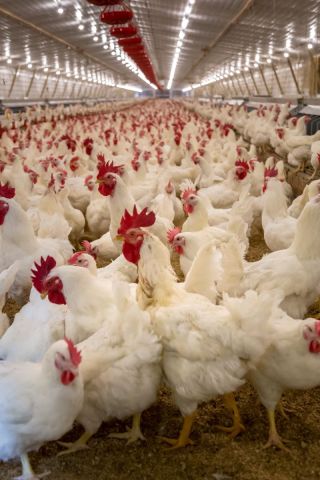Diet
Eating Ourselves Into the Next Pandemic
How eating meat causes us to deny dangerous health risks.
Posted May 30, 2023 Reviewed by Michelle Quirk
Key points
- We often think of pandemics as originating from foreign sources.
- Our own diet laden with meat from factory farms can spread diseases and pose a future pandemic risk.
- Eating meat motivates us to deny connections between our diet and disease risk.
.jpg?itok=CqYF38Ay)
In the aftermath of COVID-19, it is tempting to characterize pandemics as problems foreign in origin, traced to shadowy wildlife markets and unhygienic conditions. Indeed, such “wet” markets sometimes sell and slaughter wild, exotic animals on site leading to concerns that diseases may spread there across species. Expert calls for global bans on wet markets and the consumption of wildlife have been met with overwhelming approval.
The Disease Threat From the Factory-Farmed American Diet
It is much harder to acknowledge how our own typical meat-laden American diet spreads infectious diseases. Most infectious diseases are zoonotic—transferred from humans to animals—and result directly from domesticating animals. Consider the examples of measles, smallpox, and influenza, which, over the last century, killed hundreds of millions of people. The 75 billion cases of deaths from the common cold appear to have originated in camels. Then there’s the 1918 Spanish Flu which killed upward of 50 million people and likely emerged from a pig farm as avian influenza mutated within the pigs. We’ve paid a tremendous price for our use of animals, well before and beyond wet markets in Huanan.

These diseases are not simply a remnant of the past. Over the last 30 years, more than 30 new diseases have emerged, an unprecedented rate, the majority caused by pathogens originating from animals or from products of animal origins. There’s growing evidence that 60 percent of all infections present in humans are caused by unidentifiable pathogens resulting from animal viruses. The U.S. Institute of Medicine fears that, unabated, we may soon face a “catastrophic storm of microbial threats.”
In addition to the three pandemic-level coronavirus outbreaks in the last two decades (SARS, MERS, and COVID-19), there are 1.7 million viruses currently located in wildlife. You’ve likely heard of H1N1 (swine flu)—a flu pandemic—or H5N1 (bird flu), which evolved on pig and chicken factory farms, respectively. Did you know that H1N1 over the past 10 years has killed between 151,700 and 575,400 people worldwide? You’ve likely not heard of HMPV, a virus that probably jumped from birds to humans and causes as much misery in the United States each year as the flu. Or of the avian flu H7N9, which has a fatality rate of 40 percent. One health security expert wrote, “If H7N9 achieves sustained human-to-human transmission, it would arguably be the worst health and national security threat faced by the world in literally a century…perhaps (being) much worse than the pandemic of 1918.”

The chief driver of these new diseases, according to the World Health Organization, the United Nations, and the top veterinary authority group in the world? Increasing demand for animal protein. Our appetite is literally killing us, as we eat our way to the next pandemic. How so?
To meet our insatiable demand for meat, we have developed a system of industrial animal agriculture (“factory farming”) that cultivates these terrifying zoonotic diseases. In factory farms, the scale of production and overcrowding of stressed animals increases their risk of disease contraction and transmission, including to humans. The risk is exacerbated because factory-farmed animals are increasingly genetically similar and, thus, more vulnerable to infections and epidemics. In 2016, the UN Environmental Program warned that the “livestock revolution” was a “zoonotic disaster waiting to happen.”
But the general public does not recognize this dangerous reality of our very own food system. Here's how the writer Jonathan Safran Foer put it:
Imagine if our military leaders told us that almost every terrorist in recent memory had spent time in the same training camp, but no politician would call for an investigation of the training camp. Imagine if we knew that those terrorists were developing weapons more destructive than any that has been used, or tested, in human history. This is our situation when it comes to pandemics and farming.
Foer is correct about our blindness. Consider that in a recent study, only 15 percent of Americans agreed that there is a direct connection between disease outbreaks and livestock farming.
The Meat-Motivated Mind
An important point to add is that eating meat makes it harder to see this connection. Our minds become motivated to contort meat-related information so that our behavior seems defensible. Being attached to meat eating serves as a psychological barrier making it easier to ignore information about how animal agriculture and factory farming threaten our well-being and to ignore solutions that forgo meat consumption. We don’t want to worry about being responsible for the next pandemic, and, so, we pretend otherwise.
A team of leading researchers on the psychology of eating meat including Kristof Dhont, Jared Piazza, and Gordon Hodson asked participants to estimate how much the current and past spread of infectious diseases resulted from three sources: (1) human preparedness of pandemics (e.g., “the lack of international health care cooperation”); (2) the consumption and trade of wild animals (e.g., “unhygienic circumstances of wet markets where animals are being slaughtered”); and (3) factory farming and meat consumption (e.g., “close contact between humans and animals in the animal agriculture industry”).
Those more committed and attached to eating meat—for instance, not wanting to eat meals without meat—were less likely to believe that factory farming was linked to zoonotic diseases.
The researchers also asked participants to consider solutions that would prevent or reduce the threat of infectious disease spread, again targeting the same three categories. Similarly, those with a greater appetite for meat were less likely to endorse the notion that factory farming needed to be changed to prevent future disease outbreaks. Our stomachs guide our judgments.
These results reveal that we overlook the risk that our meat-laden diet plays in the spread of infectious diseases. It’s possible, though, that participants were simply ignorant of the facts, not that they were motivated to minimize the role played by their diet in future pandemic risk. To find out, Dhont and his team randomly assigned additional participants to read information highlighting zoonotic disease risk from either wild animal markets or factory farms.
A portion of the text read as follows:
According to scientists at the World Health Organization, the majority of all known infectious diseases are zoonotic…infectious diseases often jump from animals to humans on wild animal markets (or factory farms) where a large number of wild animals (or farmed animals) are being kept in confinement…in unhygienic circumstances before they are being sold and slaughtered for their meat. Scientists have been warning us for many years that wild animal markets (or factory farms) are one of the most important causes of infectious diseases.
Participants then indicated their agreement with different solutions to reduce or prevent infectious diseases. The results mirrored the earlier study: Even when presented with information that factory farming plays a key role in transmitting and spreading infectious diseases, those more attached to eating meat refused to accept preventive solutions targeting animal agriculture. Instead, they preferred reactionary solutions, such as developing a global information system for pandemics. We disregard proposed solutions that implicate or threaten our dietary habits.
Conclusion
Eating meat hinders us from perceiving and recognizing certain realities. Other new research shows that those most attached to eating meat avoided information about food animals’ sentience, were less interested in learning about intelligent food animals, and were quicker to stop pop-ups containing information about the minds of food animals. Committed meat eaters endorse all sorts of justifications and rationalizations for eating meat including denying animal pain and mind, and endorsing that meat is necessary, normal, and natural; that humans are superior to animals and meant to eat them; and that meat tastes too good to abandon. All of these psychological distortions reduce our cognitive dissonance and help us feel better about eating meat.
Perhaps the most dangerous distortion of the meat-motivated mind is to deny the extent that factory farming contributes to infectious diseases and to minimize its risk in generating future pandemics. With such psychological barriers in place, there is no support for solutions that target factory farming. I wonder if the meat-motivated mind also downplays the role of factory farming in contributing to climate change, or to global hunger, or to the various other serious problems that eating meat produces?
References
Dhont, K., Piazza, J., & Hodson, G. (2021). The role of meat appetite in willfully disregarding factory farming as a pandemic catalyst risk. Appetite, 164, 105279.
Leach, S., Piazza, J., Loughnan, S., Sutton, R. M., Kapantai, I., Dhont, K., & Douglas, K. M. (2022). Unpalatable truths: Commitment to eating meat is associated with strategic ignorance of food-animal minds. Appetite, 171, 105935.
Rothgerber, H. (2013). Real men don’t eat (vegetable) quiche: Masculinity and the justification of meat consumption. Psychology of Men & Masculinity, 14, 363–375.
Safran Foer J, Gross AS. We have to wake up: factory farms are breeding grounds for pandemics. The Guardian. April 20, 2020.




